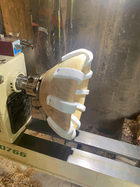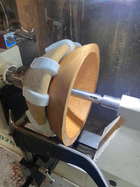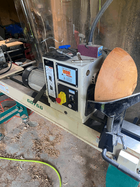Greetings, I've been a member for around a year. I intended to make a post in Introductions, but I'm a lurker and don't stick my head up often.
Anyway, I have a coring system and I usually pop out the smallest core first then work my way out. I don't like jamming the cores and putting a tenon on it just go out of round anyway, and I like to leave the decision of tenon/recess till later.
I like the method, that seems to be attributed mostly to Richard Raffan, of putting a recess on the inside of the roughed and dried bowl blank. Finishing the outside and refining the tenon/recess, then flipping for the inside.
Problem is to get the bowl blank in place to make a recess on the inside. I usually would take the core, use some sort of jam chuck, or Glen Lucas's bowl reversing plate, make a tenon and start from there. But I'd really like to skip this step. And I tend to like a recess for the cores anyway.
So I took a dried bowl blank I thought would be a good size/shape for most cores, and put on some 1/2 inch adhesive neoprene strips. I took a little inspiration from odd-not's Mono vacuum chucks. I have the number 3 and I really like it so far. I actually think the number 5 may also work well for this 'problem'. Some day soon I hope to get it and try it out.

 www.odd-not.com
www.odd-not.com
So I get my tailstock and banjo reachable and ready. Put the core in hold it with my right hand, manually turn it getting side/end grain edges matching, move the tailstock in and cut the recess. Having the right tool to cut the recess between the tailstock and side of bowl is key here. Then I can flip it and finish the outside and decide on recess or tenon, flip finish inside, flip and vacuum to finish the foot.
So far I'm really happy with the results. I was worried the 1/2 neoprene might give too much when cutting, but that hasn't seem to be an issue, yet.
Has anyone else had solutions to the same problem? Critiques/criticisms welcome.
Anyway, I have a coring system and I usually pop out the smallest core first then work my way out. I don't like jamming the cores and putting a tenon on it just go out of round anyway, and I like to leave the decision of tenon/recess till later.
I like the method, that seems to be attributed mostly to Richard Raffan, of putting a recess on the inside of the roughed and dried bowl blank. Finishing the outside and refining the tenon/recess, then flipping for the inside.
Problem is to get the bowl blank in place to make a recess on the inside. I usually would take the core, use some sort of jam chuck, or Glen Lucas's bowl reversing plate, make a tenon and start from there. But I'd really like to skip this step. And I tend to like a recess for the cores anyway.
So I took a dried bowl blank I thought would be a good size/shape for most cores, and put on some 1/2 inch adhesive neoprene strips. I took a little inspiration from odd-not's Mono vacuum chucks. I have the number 3 and I really like it so far. I actually think the number 5 may also work well for this 'problem'. Some day soon I hope to get it and try it out.

#5 Mono — OddNot
The #5 Mono is our largest size vacuum chuck in our premium vacuum chuck lineup with a 1 1/4”-8 thread. It measures 5 inches at it’s outside diameter and has the greatest holding force in the Mono series.
So I get my tailstock and banjo reachable and ready. Put the core in hold it with my right hand, manually turn it getting side/end grain edges matching, move the tailstock in and cut the recess. Having the right tool to cut the recess between the tailstock and side of bowl is key here. Then I can flip it and finish the outside and decide on recess or tenon, flip finish inside, flip and vacuum to finish the foot.
So far I'm really happy with the results. I was worried the 1/2 neoprene might give too much when cutting, but that hasn't seem to be an issue, yet.
Has anyone else had solutions to the same problem? Critiques/criticisms welcome.






